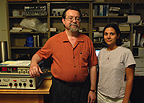October 04, 2007
Researchers win NSF grant for adsorption study

Caption follows story
Aldo Migone, professor and chairperson of the Department of Physics in the College of Science at SIUC, and Maria de las Mercedes Calbi, assistant professor of physics, are working together on a three-year project funded by the National Science Foundation. The project, "Polyatomic Adsorbates on Carbon Nanotube Bundles," will receive $330,000 from the NSF.
Migone and Calbi will use both laboratory experiments and theoretic modeling on a computer to study how certain molecules attach themselves to bundles of carbon nanotubes, structures so small that 1 billion could fit in a meter. The process, known as adsorption, describes the way molecules of gas or liquid attract to the surface of a solid or liquid and stick there, forming films.
Carbon nanotubes offer, relatively speaking, "large" accessible areas for molecules to cling to, making them well suited for adsorption studies. In the past, most of these studies focused on spherical-shaped molecules, even though most technological applications likely would involve molecules of various shapes and lengths. Migone and Calbi, therefore, plan to focus on the adsorption of linear and quasi-linear molecules.
Ultimately, the research could lead to the development of an extremely fine "filter" that could separate certain types of molecules from others based on their size, shape and other factors. Such a process would be far more efficient than current ones in use, which largely rely on cooling mixed gases into liquids in order to separate them. It could also lead to new types of storage technologies.
Migone will run lab experiments in which he places nanotubes in a vacuum chamber and introduces different gases at various temperatures and pressures and then measures how much of the gas attaches to the nanotube material. Calbi will run simulations of these experiments on a computer, providing double checks on lab results as well as the ability to "see" the theoretical molecular activity through animation. Each researcher will employ several students to help with their work.
Together, the two SIUC researchers are looking at the kinetic aspects of the process, which involves studying how molecules go from the gas phase to form a film on the nanotube surfaces. They also will work with researchers at the Universidad Nacional San Luis in Argentina, who will study the structures and properties of the adsorbed films once equilibrium is established in the film.
Both researchers and the students will travel annually to Argentina as part of the study. Calbi and an undergraduate made the first visit in May, and later in August Migone went to Argentina with a graduate student.
"At this point we just want to study how the molecules attach to the nanotubes," said Migone, the principal investigator on the study. "We'll then identify how different parameters such as temperature and pressure affect this process."
Molecules are attracted to the tiny openings provided by the tubes and spaces between the tubes. The smaller the opening, the stronger the attraction, Calbi said, as long as the molecules are small enough to fit inside the openings. Part of the research will examine what structures work best for certain molecules.
"The different shapes of the tubes and the molecules and how the molecules attach in various ways, it's very complicated from a fundamental point of view," Calbi said.
Migone compared the carbon nanotubes to a sponge and the gases to water.
"There is no chemical bond between the two," he said, explaining that the adsorbed molecules can be expelled from the nanotubes using heat or vacuum somewhat the way water can be squeezed from a sponge.
The two hope their work will lead to industrial and engineering advances.
"With all the advances in nanotechnology during the last few years it's possible to build things no one could imagine before," Calbi said.
Caption: Tiny technology – Aldo Migone, left, professor and chairperson of the Department of Physics at Southern Illinois University Carbondale, and Maria de las Mercedes Calbi, assistant professor of physics, are working together on a three-year project funded by the National Science Foundation. The project, "Polyatomic Adsorbates on Carbon Nanotube Bundles," will receive $330,000 from the NSF. Migone and Calbi will use both laboratory experiments and theoretic modeling on a computer to study how certain molecules attach themselves to bundles of carbon nanotubes, structures so small that 1 billion could fit in a meter. The process, known as adsorption, describes the way molecules of gas or liquid attract to the surface of a solid or liquid and stick there, forming films. Their work could lead to highly efficient "filters" that work the molecular level and new storage systems.
Photo by Steve Buhman
